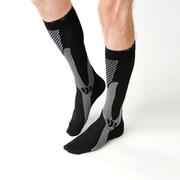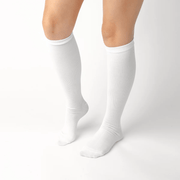There are so many different types of compression socks on the market, how do choose the right ones? It is important to select the best socks to get the most benefit from wearing compression socks.
First of all you need to identify why you need to wear compression socks.
Why do you want to wear compression socks?
The first step to choosing the right compression socks is to identify what purpose they will serve. Are you on your feet all day and want to reduce the aching in your legs at the end of the day? Or are you travelling long distances or sitting for long periods of time and want them to provide comfort? Have you just had surgery and need to increase circulation in your legs? Do you have a medical condition such as varicose veins or diabetes that decreases blood circulation that causes swelling and pain? Once you understand the reason you need compression socks, you can choose the right ones to suit your situation.
How much compression do you need?
Before you start, understand that compression is measured in mmHg (millimetres of Mercury). This is the same measurement used for taking your blood pressure. Compression socks range from 15 mmHg up to 40 mmHg so it is important to choose the best compression for your specific purpose:
- 15 – 20 mmHg. You can buy these over-the-counter and are good for daily wear, while travelling and for sports. They improve your circulation without being too tight.
- 20 – 30 mmHg. These a great for more support and for varicose and spider veins, after surgery and to assist with swelling.
- 30 – 40 mmHg. This level of compression is good for daily wear and recovering from a medical condition. They help you manage symptoms that are moderate to severe. The level of compression is good for preventing blood clots forming, severe swelling and varicose veins and for use after an operation.
What type of compression socks to choose
The type of compression sock you choose, depends on the area of your legs affected. The different types of compression socks include:
- Knee high. Knee high compression socks pull up to just below your knee and are suitable for conditions from the knee down.
- Thigh high. Thigh high compression socks pull up to the top of your thigh and can improve circulation in your entire leg.
- Waist high. Waist high compression socks are just like pantyhose. These are good for bringing the swelling up and out of your legs. They also stop blood pooling in your abdominal area.
Select the right type of material
The following are the different types of fabric compression socks come in and the situation they are suited to:
- Sheer materials. Compression socks made of lightweight, transparent sheer materials are fashionable made specifically for women. While they are fashionable, they are not durable and may not provide the compression you need.
- Opaque materials. Opaque materials are more durable and suit both men and women. They are strong enough to give your legs the compression they need while being comfortable. Opaque materials are excellent for varicose veins, after an operation and for swelling.
- Wool, cotton and high tech blend materials. These materials make ideal compression socks for playing sport or running or wearing daily. The are long-lasting and made to control moisture and heat. Compression socks made with wool, cotton or high tech blends are usually only available in compression levels from 15 to 30 mmHg.
Getting the right fit
It is also important that your compression socks fit correctly. Make sure you measure the circumference of your calf to help choose the right size. They should have a snug fit around your leg and feet without being too tight, and should be comfortable.
 Active Compression
Active Compression
 Plain Compression Socks
Plain Compression Socks

